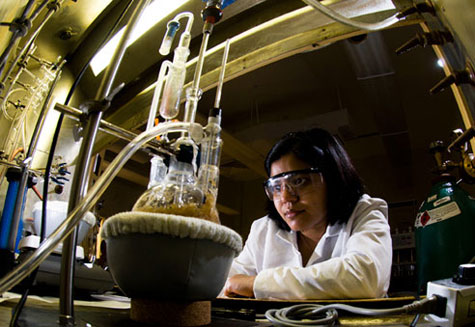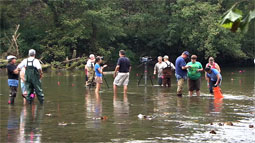 |
|
||||||
|
|
|||||||||||||||||||||||||||||||
Ear to the ground, eye on the sky
From nanotechnology and polysaccharides in medicine to numerous military partnerships and international research projects, surprises paint the landscape of CNRE, considered by peer institutions to have some of the top programs of their kind in North America. Researchers in the Department of Wood Science and Forest Products are working to put sustainable, natural polysaccharides in everyone's medicine cabinets. While the safety and renewability of polysaccharides from trees, lobster shells, and other natural sources are great features, they aren't the primary reason for researchers and consumers to get excited. "The main thing is that polysaccharides can make medicines work better, and they can do much better than almost any other material, petroleum-based or otherwise," explained biomaterials Professor Kevin Edgar, who also directs Virginia Tech's Bio-Based Materials Center in the Institute for Critical Technology and Applied Science. His research group has made recent progress in developing polysaccharide derivatives to attack disease-causing organisms like the tuberculosis bacterium and HIV. It's difficult to imagine cutting a meter stick into one billion pieces. But that's the size of a nanometer, and CNRE scientists are working at this small scale with some big goals in mind. Edgar and his fellow researchers have figured out how to make tiny particles that can explosively enhance the solubility of tuberculosis medications in water while easily containing multiple drugs. These multi-drug particles can help patients by lowering the dose required and thus reducing cost and side effects.
In addition to enhanced drug delivery, dozens of military projects are under way in the college's four departments, its Conservation Management Institute (CMI), and other centers. CMI works to conserve natural resources around the world by providing research and development services to agencies and organizations and has led Department of Defense-funded (DOD) projects at military sites across the country. For example, DOD is funding a cooperative research effort at the Fort Pickett Maneuver Training Center near Blackstone, Va., to proactively address declining populations of the Atlantic pigtoe mussel before it is listed as endangered. In another Fort Pickett project, CMI biologists are studying the patterns of training disturbances, such as heavy vehicles and fire, to help natural-resource military personnel manage lands. Even archaeology is in play at Fort Pickett, where CMI's Beverly Boyko is a curator for the Virginia National Guard's archaeological and historical collections, documenting the guard's history back to its inception in 1607 and preserving other artifacts as old as 10,000 B.C. Many of the college's projects have a broad scope and a global scale. CNRE has established partnerships and research programs in more than 30 countries. Wildlife Assistant Professor Sarah Karpanty has led projects in Madagascar since her undergraduate days, examining wildlife and endangered-species management and forest restoration. More than 80 percent of the island's living things are found nowhere else on Earth, a tapestry of biodiversity threatened by slash-and-burn agriculture, mining, and logging. While many CNRE scientists look toward the earth for answers, others are now turning an eye toward the sky. Phone calls from interested students have been coming in from across the nation as word spreads that CNRE's geography department will start offering an undergraduate program in meteorology this fall. "The wealth of concern about the changing environment around us is evident to all members of society almost daily," said department head Bill Carstensen, ticking off a host of societal issues affected by changing climate patterns. To address these issues, CNRE is responding with an academic program that blends meteorology and geospatial science. Meteorology studies the atmosphere while geospatial science largely studies the land and water surfaces. The program will provide students with technical life skills and will develop the science and knowledge needed to resolve the environmental challenges of the future. "There is so much more to the College of Natural Resources and Environment than meets the eye," said CNRE Dean Paul Winistorfer. "Our root is local, but our reach today is global in the important work we must do to steward our natural resources and the environment. We are taking a fresh look at all we do to make sure we are positioned to be of maximum value to society and our resources." Lynn Matthews Davis is the director of communications for the College of Natural Resources and Environment.
|
|
||||||||||||||||||||||||||||||
|
|
|||||||||||||||||||||||||||||||






